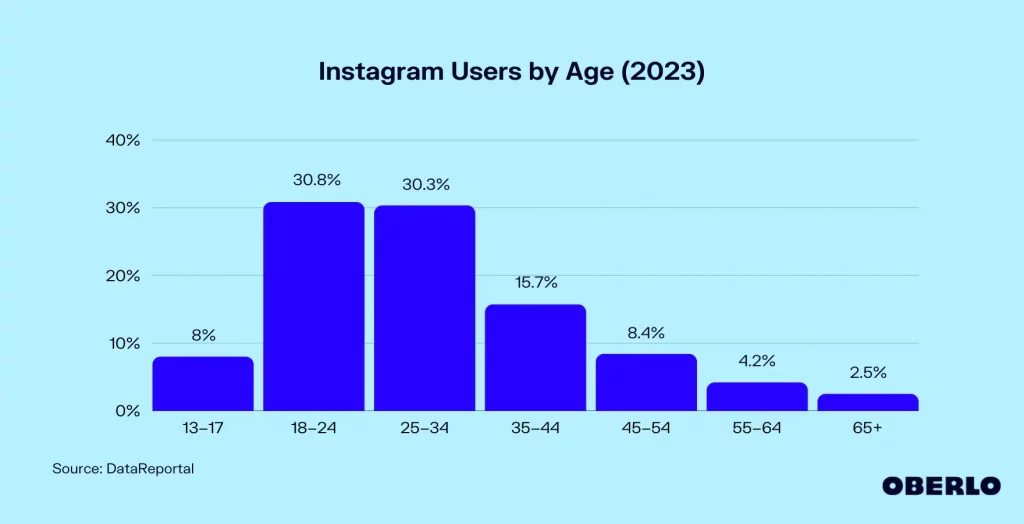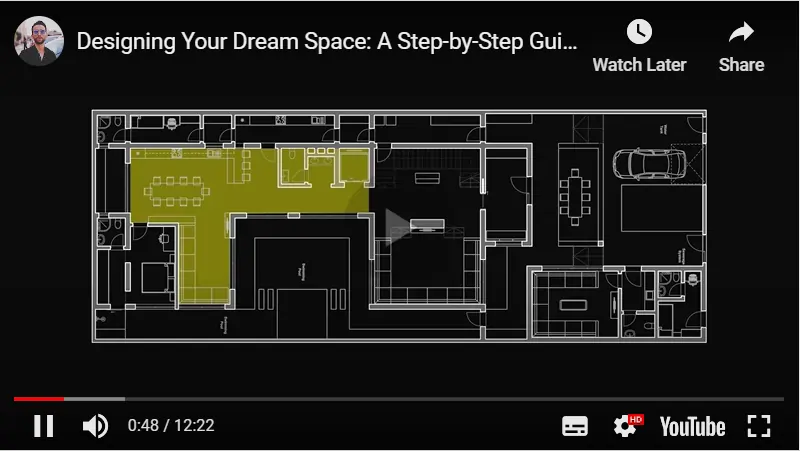Table of Contents
Social media has become a vital part of the interior design industry. It offers interior designers a way to showcase their portfolio and network with peers and new clients to build a reputation.
Despite the rising importance of social media in the interior design industry, 8 out of 10 designers believe social media does not deliver on its promises. The reason is a lack of social media strategy. Success in social media requires answers to questions like
- Which is the right platform for your business?
- What kind of content should you post, and how often?
- How do you measure your social media performance and ROI?
We will help you find answers and provide a step-by-step process to improve your social media success as an interior designer.
Whether you are looking for social media tips or wondering how to use social media for your interior design business, this article is for you. Let’s dive in!
#1. Define Your Target Audience
The first step in developing a social media strategy for interior design marketing is to define the target audience. This involves identifying the people you want to reach through social media marketing efforts.
To accomplish this, you can follow these steps:
Step 1. Identifying Your Target Audience
Start by conducting market research to gain insights into your potential customer’s demographics, psychographics, and behaviors. Consider age, gender, location, income level, and occupation.
Determine whether your focus will be on residential or commercial clients or a combination. This step helps you narrow your audience and tailor your social media content to their needs.
If you observe the above Instagram post, the interior designer leverages a group of customers and targets them with specific posts based on keen interests in aesthetics.
Similarly, you can group specific customers according to their preferences and have targeted social media marketing efforts.
Step 2. Create Buyer Personas
Once you have gathered information about your target audience, develop buyer personas. These are fictional representations of your customers based on your collected data.
Each persona should have a name, background information, and specific characteristics that reflect aspects.
- Audience’s interests
- Motivations
- Challenges
- Preferences.
By creating buyer personas, you can create content that resonates with their profile and have better engagement.
Step 3. Understand Their Interests and Preferences
Dive deeper into your target audience’s interests and preferences to shape your social media strategy. Explore the topics, trends, and hashtags popular among your audience.
Consider their preferred social media platforms and the type of content they engage with the most. This will help you determine the right tone, style, and visuals to incorporate into your social media posts.
By defining your target audience, creating buyer personas, and understanding their interests, you lay a solid foundation for your social media strategy.
#2. Choose the Right Social Media Platforms
Choosing the target social media platform is crucial once you have identified the audience and determined their interests. Interior designers know what styles work for different spaces, but choosing a social media platform can get tricky.
Overview of Popular Social Media Platforms
Different types of social media platforms have specific audiences. For example, Instagram has a maximum audience of 18-34-year-olds. So, you need clarity on what age group, gender, or ethnicity you want to target to choose a social media platform.

Some of the popular social media platforms which interior designers use are,
- Tiktok
- Dribble
Identifying the Best Platform(s) for Your Business
The first step in choosing the right social media platform is to consider your overall marketing goals. Identifying your objectives will help you narrow down the platforms that align with your desired outcomes.
For instance, if your primary goal is increasing brand awareness, platforms like Pinterest are a great choice. This visually-oriented platform allows you to showcase your design projects, inspire your audience, and build a strong brand presence through captivating imagery.
Key Features of Each Platform
Consider the type of content you want to create and share with your audience. Different platforms offer varying formats and features that can accommodate specific content types. If you aspire to share longer video content, YouTube is a prime choice.

YouTube provides a dedicated space for tutorials, design trends, and in-depth discussions, allowing you to establish yourself as an expert. Additionally, YouTube’s search functionality can help your videos reach a broader audience organically.
Before committing to a social media platform, evaluate the time you can realistically dedicate to creating and posting content. Consistency is key to maintaining an active presence on social media, but choosing a platform that aligns with your schedule is important.
If time is a constraint, Twitter may be a suitable option. With its character limit, Twitter allows for quick and concise updates, making it easier to maintain a consistent posting schedule without investing excessive time.
#3. Create a Social Media Strategy
Creating an impactful social media strategy for interior designers involves several crucial steps.
Set Specific Goals
Before diving into content creation, establish specific goals for your social media strategy. Are you aiming to increase brand awareness, generate leads, or showcase your portfolio?
Setting measurable and achievable goals will guide your efforts and help you track your progress.
Creating a Content Plan
Consider the level of competition on each platform you’re considering. For example, if Instagram is already saturated with interior designers showcasing their work, it might be worth exploring alternative platforms like TikTok or LinkedIn.
Based on the competition, social media strategy, and kind of audience you want to target, create a content plan.
It involves the following steps:
- Conduct competitor analysis: Study your competitors’ social media presence to gain insights into what content works well in the interior design industry. Analyze their strategies, content types, engagement levels, and posting frequency. Use this information to differentiate yourself and find opportunities to stand out.
- Develop a content strategy: Plan the content you want to create and share on social media. Here are some ideas for content that can be effective for interior designers:
- Inspirational photos: Showcase your portfolio by sharing visually appealing images of your past projects.
- Before and after transformations: Display the dramatic changes you’ve made to spaces to inspire and captivate your audience.
- Design tips and tutorials: Share practical tips, tricks, and DIY ideas your audience can implement in their homes.
- Behind-the-scenes glimpses: Give your audience a sneak peek into your design process, materials selection, or team collaboration.
- Client testimonials: Highlight positive feedback and testimonials from satisfied clients to build credibility and trust.
- Industry news and trends: Stay updated with the latest interior design trends and share your insights on popular styles, colors, or materials.
- Plan your content calendar: Create a calendar to organize and schedule your content. Determine the frequency of posting and assign specific content types to different days or time slots. Consistency is key to maintaining engagement and growing your following.
Tips for Creating Engaging Content
Consistency is key to creating engaging content and an effective social media presence. Another key aspect is getting the right mix of content for your social media strategy.
Best practices for scheduling and posting content
Some best practices to create engaging content include getting the right mix of content formats, posting consistently, and more.
Mix up Your Content Formats
Don’t limit yourself to just images or photos. Experiment with different content formats like videos, GIFs, infographics, or live streams to keep your audience engaged and interested.
Maintain Consistency
Develop a posting schedule and stick to it. Consistent posting keeps your audience engaged and helps establish your brand as reliable and trustworthy.
There is no trick to predict the best frequency of posts on any social media platform. However, here are some recommendations for posting frequency on social media for interior design businesses,
- Instagram posts: 3-5 times/week.
- Instagram stories: 2 times/day.
- Twitter: 2-3 times/ day.
- Facebook: 1-2 times/ day.
- LinkedIn:1-2 times/ day.
- TikTok: 3-5 times/week.
- Pinterest: 1 time/week.
Improve Social Media Engagement
Social media is a two-way communication channel. Encourage audience interaction by responding promptly to comments, messages, and inquiries. Engage with your followers and build a social network by asking questions, hosting contests or giveaways, etc.
Analyze and Monitor Social Media Performance
Regularly monitor your social media analytics to gain insights into the performance of your strategy. Analyze engagement rate, reach, and follower growth metrics to assess what works best for your audience. Use these findings to refine your approach and adapt your content accordingly.
#4. Build Your Social Media Presence
To establish a substantial social media presence, it is crucial to start by setting up your social media profiles effectively.
Step 1 Set up Social Media Profiles
Take the time to carefully craft each profile to reflect your brand and attract your target audience. Craft concise and compelling descriptions for your profiles. Communicate what your brand stands for, its value, and why users should follow you.
Further, invest in high-quality visuals, such as profile pictures and cover photos, that accurately represent your brand. Use eye-catching images that evoke your brand’s personality and resonate with your audience.
Step 2 Optimize Your Social Media Profiles
Once your social media profiles are set up, it’s time to optimize them to enhance visibility and attract more followers. Consider the following tips to make the most out of your profiles:
- Keyword Optimization: Incorporate relevant keywords in your profile descriptions and bios. This will help search engines and social media algorithms better understand your brand and improve your chances of appearing in relevant searches.
- Consistent Branding: Maintain consistency across all your profiles to reinforce your brand identity. Use consistent colors, fonts, and tone of voice that align with your brand guidelines.
- Complete Profile Information: Fill out all the necessary fields in your profiles, providing comprehensive information about your brand. Include links to your website, contact details, and any other relevant information that users may find valuable.
Step 3 Building a Consistent Brand Image
Consistency is key when it comes to building a strong brand image on social media. Follow these guidelines to establish a cohesive and recognizable brand identity:
- Visual Consistency: Use consistent visual elements, such as color schemes, filters, and graphic styles, across all your social media posts. This creates a cohesive visual identity that users can easily associate with your brand.
- Tone of Voice: Develop a consistent tone that aligns with your brand values. Whether casual, professional, humorous, or informative, ensure your brand’s voice remains consistent in social media interactions.
- Engaging Content Strategy: Plan and create content that aligns with your brand and resonates with your target audience. Use a mix of informative, entertaining, and interactive posts to keep your followers engaged and encourage interaction.
Step 4 Increasing Engagement with Followers
To foster an active and engaged community on social media, implement these strategies to boost engagement:
- Respond to Comments and Messages: Regularly monitor your social media accounts and respond promptly to comments and messages from your followers. This shows that you value their input and encourages further engagement.
- Encourage User-Generated Content: Prompt your followers to create and share content related to your brand. This could include contests, challenges, or simply asking for their opinions. User-generated content boosts engagement and helps spread awareness of your brand.
- Consistent Posting Schedule: Establish a consistent posting schedule to keep your followers informed and maintain their interest. Consistency helps build trust and ensures your content reaches your audience when they are most active.
#5. Measure Your Social Media Success
To measure your social media success, you can follow these steps:
Step 1 Identify Key Metrics
Start by determining the key metrics that align with your business goals. These metrics will depend on what you want to achieve, such as increasing brand awareness, driving website traffic, or boosting engagement.
Common key metrics include follower count, reach, impressions, engagement rate, click-through rate, conversions, and customer sentiment.
Step 2 Use Tools for Tracking Metrics
Many social media platforms like Facebook, Twitter, and Instagram provide built-in analytics tools that offer insights into your account’s performance. These tools usually include metrics specific to each platform.
Further, tools like Google Analytics, Hootsuite, Sprout Social, and Buffer provide more comprehensive analytics across multiple social media platforms. They offer advanced features such as cross-platform comparison, audience demographics, and campaign tracking.
Step 3 Analyze Your Social Media Performance
Regularly review and analyze the metrics provided by the tracking tools. Look for patterns, trends, and correlations to gain insights into your social media performance. Consider the following aspects:
- Engagement Measurement: Measure the level of engagement your content generates, such as likes, comments, shares, and retweets. This indicates how well your audience is interacting with your posts.
- Reach and Impressions: Assess the number of people who see your content (reach) and the number of times it’s displayed (impressions). This helps evaluate your content’s visibility and potential impact.
- Conversion Metrics: If your goal is to drive specific actions like website visits, downloads, or purchases, track the conversion metrics associated with your social media campaigns. This could include click-through rates, sign-ups, or completed purchases.
- Sentiment Analysis: Monitor the sentiment of comments and mentions related to your brand. Positive sentiment indicates a strong brand image, while negative sentiment might require addressing any issues promptly.
Step 4 Adjust Your Strategy Based on Data
Use the insights gathered from your analysis to make data-driven adjustments to your social media strategy. Based on the findings, consider the following actions:
- Content Optimization: Identify the types of content that resonate the most with your audience and create more of it. Experiment with different formats, topics, and styles to keep your content fresh and engaging.
- Posting Schedule: Analyze the best times and days to post for maximum reach and engagement. Adjust your posting schedule accordingly to increase visibility and interaction.
- Audience Targeting: Refine your target audience based on the demographic information available in the analytics. Tailor your content and advertising campaigns to better align with your audience’s interests and preferences.
- Campaign Optimization: If running social media campaigns, evaluate their performance and optimize accordingly. Adjust targeting, messaging, and creative elements based on the data to improve results.
Conclusion
Social media offers opportunities to connect with potential clients, showcase their work, and drive business growth. So, there is no denying how to use social media for your interior design business is an essential question.
We have tried to answer it with a comprehensive social media strategy, although the strategy to improve the presence of social media for your interior design business can differ from others.
The core of social media strategy is content that you create to showcase interior design expertise. This is where Foyr can help you with a convenient solution, granting them access to a vast collection of 50,000 pre-designed and pre-modeled elements.
By utilizing Foyr Neo, interior designers can promptly showcase their furniture concepts to clients. If you wish to experience a more efficient interior design workflow, we invite you to sign up for a complimentary 14-day trial of Foyr Neo.
FAQs
How do interior designers use social media?
Interior designers use social media to showcase their work, connect with potential clients, and stay up-to-date with industry trends. Here are some common ways interior designers use social media:
They can share photos of completed projects, design inspiration, and behind-the-scenes shots of their design process. Further, they can share their experience, skills, and accomplishments to expand their network.
Social media can be used as a marketing tool to promote interior design services, products, or events. Interior designers can collaborate with other designers, influencers, or brands on social media to expand their reach and gain exposure to new audiences. They can also participate in design challenges or events to showcase their work and connect with other designers.
How can I promote my interior design business?
You can share photos of your completed projects on social media channels like Instagram and Pinterest to showcase your design skills and attract potential clients.
Further, you can create a website with a portfolio of your work, client testimonials, and a blog that can help establish your brand and attract clients.
How do I promote my interior design business on Instagram?
Consistently post high-quality photos of your completed projects and design inspiration. This helps establish your brand and attract potential clients.
Further, you can share behind-the-scenes photos of your design process to give your followers a glimpse into your work. This helps build trust with potential clients and establishes you as an expert in the industry.
How social media affects interior design?
Social media has provided interior designers with a platform to showcase their work to a broader audience. Platforms like Instagram, Pinterest, and Houzz have made it easier for designers to share their projects and design inspiration with people worldwide.
Social media has become a source of inspiration for many people looking to decorate their homes. Platforms like Pinterest and Instagram are filled with ideas and inspiration that people can use when designing their spaces.








